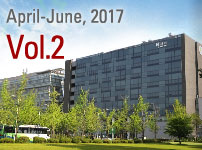SUNGKYUNKWAN UNIVERSITY (SKKU), SEOUL, KOREA
- Prof. CHANG Discovers New Way to Achieve Ultra-High Resolution
Images of Various Tissue Samples - A Wet-Tolerant Adhesive Patch Inspired by Protuberances in Suction Cups of Octopi
- Prof. KIM Kihyun Found Natural Materials From a Termite-associated Amycolatopsis sp. M39
- Prof. KANG Jongsun & CHO Hana Demonstrate the Role of Cdon in Cardiac Function and
Remodeling - PBS Introduces a Research by Prof. KIM Younghan
- Development of AI-based Plating Amount Control Automation Solution

Researchers at Sungkyunkwan University and Massachusetts Institute of Technology (MIT) have developed a new way to achieve ultra-high resolution images of various tissue samples with a low-cost microscopy system.
The new technique uses a swellabel hydrogel to physically expand tissue samples. Two years ago, Prof. Ed Boyden's lab at MIT showed that it was possible to expand tissue samples after forming a swellabel hydrogel inside tissue samples and then washing the sample-hydrogel composites in water, resulting in 4.5-fold linear expansion (100-fold volume expansion). Now, the researchers together at Sungkyunkwan University and MIT have shown that it is possible to expand tissue samples multiple times, resulting in 20-fold or even larger linear expansion.
Using this technique, the researchers were able to create images of tissues with a resolution of 22 nanometers, which is similar to or even better than that achieved by state-of-the-art super-resolution imaging techniques, such as stimulated emission depletion (STED) microscopy or Stochastic optical reconstruction microscopy (STORM). However, this technique is much cheaper and simpler than those delicate, complicated, and expensive techniques. Also, this method enables large-scale 3-D volume super-resolution imaging.
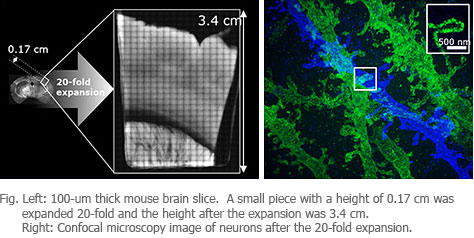
The researchers showed that this technique works well with various tissue types, including mouse brains, lungs, and livers. Prof. CHANG Jaebyum, who is the first author of the paper, which appears in the April 17 issue of Nature Methods, mentioned that this technique would be very useful in mapping neuron circuits of the brain and also studying the heterogeneity of cancer or studying the detailed process of animal development. He also added that he would like to combine artificial intelligence (AI) and this technique to enable mass-data acquisition and mass-data analysis.
Find more information at:
http://www.nature.com/nmeth/journal/v14/n6/full/nmeth.4261.html

Adhesion strategies that rely on mechanical interlocking or molecular attractions between surfaces can suffer when coming into contact with liquids. Thus far, artificial wet and dry adhesives have included hierarchical mushroom-shaped or porous structures that allow suction or capillarity, supramolecular structures comprising nanoparticles, and chemistry-based attractants that use various protein polyelectrolytes. However, it is challenging to develop adhesives that are simple to make and also perform well and repeatedly under both wet and dry conditions while avoiding non-chemical contamination on the adhered surfaces.
Prof. PARK Changhyun and his team presented an artificial, biologically inspired, reversible wet/dry adhesion system that is based on the dome-like protuberances found in the suction cups of octopi. To mimic the architecture of these protuberances, they use a simple, solution-based, air-trap technique that involves fabricating a patterned structure as a polymeric master, and using it to produce a reversed architecture without any sophisticated chemical syntheses or surface modifications.
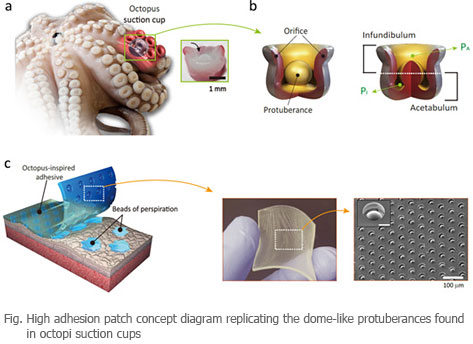
The micrometre-scale domes in their artificial adhesive enhance the suction stress. This octopus-inspired system exhibits strong, reversible, highly repeatable adhesion to silicon wafers, glass, and rough skin surfaces under various conditions (dry, moist, under water and under oil). To demonstrate a potential application, they also used their adhesive to transport a large silicon wafer in air and under water without any resulting surface contamination. Their octopus-inspired adhesives might be useful when applied over skin or a wound and so partially assist with wound healing. They note that their patches promoted wound healing less well than 3M Tegaderm, but they are investigating stem-cell and drug-loading approaches to improve their practical utility.
Find more information at:
https://www.nature.com/nature/journal/v546/n7658/full/546358a.html

From joint-research with Harvard Medical School, SKKU's research team led by Prof. KIM Kihyun of the School of Pharmacy successfully found two new natural materials from the symbiotic microorganism which was isolated from termites living in the Republic of South Africa.
Explorations of the bacterial symbionts of phylogenetically diverse insects have repeatedly led to biologically active natural products with interesting chemical scaffolds. The bacteria often provide small molecule chemical defenses that selectively inhibit the insects' microbial competitors and pathogens. The small molecule defenses found in current studies reflect the numerous rounds of mutation, selection, and amplification between the insects' defenders and antagonists.
In this research, the team put their efforts on finding selective agents from bacteria associated with macrotermes natalensis through a systematic combination of LC−HRMS-based dereplication and bioactivity assays against the basidiomycete cultivar (termitomyces spp.) and an ascomycete competitor (pseudoxylaria spp.). As a result of these studies, the actinomycete amycolatopsis sp. M39 was found to exhibit both a unique metabolomic profile and promising anti-pseudoxylaria activity.
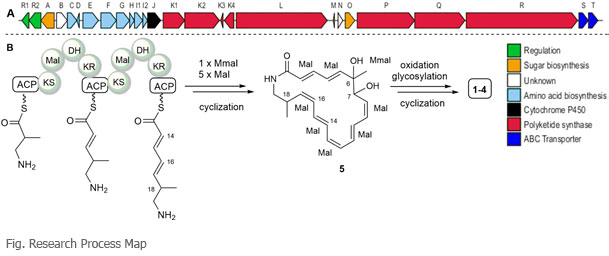
They now report the isolation and structural characterization, biosynthetic analysis, and biological activity of four new macrolactams isolated from amycolatopsis sp. M39. Two of the four macrolactams exhibited selective inhibition of the pseudoxylaria pathogen over the termitomyces cultivar.
"I hope the identification of selective antifungal compounds can demonstrate the potential of using ecologically relevant assays to identify biologically active compounds," said Prof. KIM.
This article was published in the March edition of Organic Letters by the American Chemical Society and was also supported by the Basic Science Research Program through the National Research Foundation of Korea (NRF) funded by the Ministry of Science, ICT and Future Planning.
Find more information at:
http://pubs.acs.org/doi/abs/10.1021/acs.orglett.6b03831

SKKU's research team led by Prof. KANG Jongsun of the Dept. of Medicine demonstrated the role of Cdon, a cell surface receptor, in preventing cardiac remodeling through suppression of Wnt signaling.
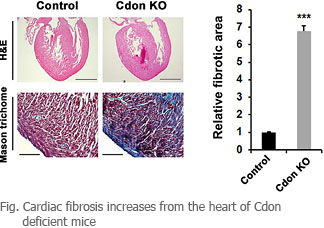 Cdon is expressed and predominantly localized at intercalated disk in both mice and human hearts. Cdon−/− mice develop cardiac dysfunction and fibrosis with altered expression of remodeling genes. Cdon deficiency causes aberrant localization and function of gap junction protein connexin 43, correlating with hyperactivated Wnt signaling. Blocking of Wnt signaling in Cdon-depleted cardiomyocytes attenuates aberrant intercellular coupling. Conversely, Wnt activator causes aberrant activation of gap junction with decreased Cdon levels, suggestive of a feedback mechanism. This data suggests that Cdon is required for the control of Wnt signaling to prevent cardiac remodeling.
Cdon is expressed and predominantly localized at intercalated disk in both mice and human hearts. Cdon−/− mice develop cardiac dysfunction and fibrosis with altered expression of remodeling genes. Cdon deficiency causes aberrant localization and function of gap junction protein connexin 43, correlating with hyperactivated Wnt signaling. Blocking of Wnt signaling in Cdon-depleted cardiomyocytes attenuates aberrant intercellular coupling. Conversely, Wnt activator causes aberrant activation of gap junction with decreased Cdon levels, suggestive of a feedback mechanism. This data suggests that Cdon is required for the control of Wnt signaling to prevent cardiac remodeling.
The research, supported by the Ministry of Science, ICT and Future Planning as a part of a project supporting the cultivation of future researchers, as well as to increase performance, was conducted mostly by Ph.D. program students: JUNG Myungho (advising professor: Dr. KANG Jongsun) and KIM Hyunji (advising professor: Dr. CHO Hana).
This study was published in one of the world's most renowned scientific research papers, Proceedings of the National Academy of Sciences, Feb. 2nd with the title, "Cdon Deficiency Causes Cardiac Remodeling through Hyperactivation of WNT/β-Catenin Signaling".
Find more information at:
https://www.ncbi.nlm.nih.gov/pubmed/28154134

SKKU Professor KIM Younghan's research entitled "The Face of Risk: CEO's Facial Masculinity and the Risk of the Firm" which was presented at the American Finance Association convention held in January of this year, was introduced on the TV Show "Making Sense" by PBS on May 25th.
Public Broadcasting Service (PBS) is the most prominent provider of television programming to public television stations in the US, and it is categorized as one of the six major commercial broadcasting networks together with NBC, CBS, ABC, etc.
"There is a strong link between facial masculinity and risk taking behavior," said Prof. KIM who is now exploring the possible link between CEO risk taking and the male hormone testosterone. In the research, the ratio of facial width-to-height ratio (fWHR), a measurement technique developed by archaeologists has been proposed as a proxy for masculinity according to the theory that it is influenced by exposure to testosterone. The hypothesis is that an individual is more masculine if they have a wider face.
Also, Prof. KIM found out that the typical ratio of fWHR in men is 1.83, but the average score for 1,162 CEOs measured by neutral 3rd parties was significantly higher than 2.0. This presents evidence that if a CEO has a wider face, they may have a higher correlation with risk taking which may lead to more mergers and acquisitions.
Prof. KIM has also begun to study the relationship between the vocal pitch and testosterone; at any given age, the lower the pitch, the higher the testosterone.
In the episode of the program, Prof. Jennifer Lerner's (Harvard Kennedy School of Government) study on the "Influence That Masculinity Has on Company Culture and Risk Taking" was also aired.

Prof. Lee Jongseok of the Department of Systems Management Engineering jointly developed an AI-based plating amount control automation solution with a research team from POSCO, South Korea's largest steelmaker. The solution precisely controls Continuous Galvanizing Line (CGL) by using AI so that it can reduce the deviation in the plating amount significantly. In particular, through a combination of the AI-based plating amount prediction model and the control model of the optimization method, this technology can predict the plating amount in real-time and meet the objective plating amount.
Prof. Jong Seok Lee made the algorithm for the AI plating amount prediction model and developed a plating amount prediction program through cooperation with POSCO's research team.
The main technology for the solution is self-learning using a big data deep learning technique. By self-learning, the AI program keeps the accuracy of the control up to date. Furthermore, it can predict and control the plating amount precisely through self-learning even when there are changes of equipment or operations.
